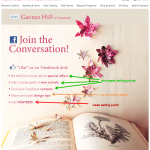“Book now” is the perfect call to action for health and wellness, right?
NO.
It’s great for an oil change. And “buy now” is great if you’re Nordstrom and you’ve got great year-end prices on cashmere sweaters.
But it’s often a lousy call to action when people are thinking about losing weight, getting off the couch so they don’t have to start statins, and making lifestyle changes so they can get off Type 2 diabetes meds like metformin.
Winning new clients and members starts long before “buy now” — with calls to action that start engaging your prospects much earlier in their decision process.
Contemplation: the top of the sales funnel
Prospects at the top of the funnel are pondering change. Their ears are perked up, their eyes are open, but their mental dialogue is tentative:
- Hmmm…that’s interesting, but…
- I know I should, but…
- One of these days…
- But what if….
They’re casting a broad net: checking out possibilities, seeing what sounds like it might be a fit — and then taking a step back as they remember prior efforts to work out, lose weight, get better control over a health issue, or step up their training and performance.
In this stage, consider the problem your prospect wants to solve. What were their previous experiences? What are their current expectations, fears and anxieties about walking in your door the first time, about showing up to the first class, session or appointment?
For example, think about this scenario: a 40-year-old woman who badly wants to lose a fair amount of weight.
Do you think it’s the first time she’s tried?
Probably not. She’s probably had more disappointments and frustrations than you can imagine. She’s probably tried things (keto, Paleo, vegetarian, Whole 30, dairy-free!) that helped other people — but didn’t help her. Other ideas were well-intentioned but unhelpful (“no white foods, ever!”).
She may well have been the target of certainly unwanted and all too often rude and unkind comments about her weight and/or food decisions — from complete strangers, her doctor, her own family and ‘friends.’
She’s probably full of secret terrors: terrified of “ending up like my mom”, terrified that she can’t actually change, terror that she’s waited too long.
That’s a lot of emotional baggage. But after 15 years in this business, we can tell you this is the norm, not the exception.
And it applies to everyone. That elite athlete you’d love to sign to your sports conditioning business? She’s remembering the last coach, whose gung-ho attitude probably worsened an unresolved injury…and she’s remembering how awful it was to DNF one event and then DNS the next one. You’ve got a lot of reassurance to do.
What’s their end-game? Where do they see themselves as they’re beginning to gain confidence? If you could look back from that time yet-to-be, how did you help them get there?
When you’re designing calls-to-action that keep people moving when they’re still early in their buying process, choose next steps that help prospects get past the emotional baggage and into the early stages of success.
Why? Because people who never unpack their baggage won’t stay. They’ll never become thrilled clients and members. They’re afraid to decide and afraid to buy because that means risking yet one more devastating, disheartening, and intensely personal failure.
That’s why “Book now” — even if it’s for a free assessment or a sample class — is incredibly premature. It only makes sense for people who have gotten past all those fears and anxieties.
Successful health and wellness marketing defines micro calls-to-action targeted to people in the top of your sales funnel: baby steps that lessen anxiety, create a feeling of self-efficacy, and build the beginnings of self-confidence.
Think bite-sized, not buffet.
An effective call-to-action for these early-stage prospects might be to sign up for your “One Tiny Thing” daily text message.
Then, every day for 30 days, subscribers get a micro-action, like:
- Today, park one row farther away from the entrance.
- Today, leave one bite of food uneaten.
- Today, check your mailbox yourself.
- Today, take one deep breath and exhale s-l-o-w-l-y.
Folks in this early stage are also having thoughts like these:
- I heard that…
- Is it true that…
- I’ll never be able to (lose weight/run faster/whatever) because I….
So next steps that dispel myths and misconceptions are also important in this stage. For example, you might
- Invite prospects to watch a streaming video on “Yes! Keto CAN Work for Vegans” followed by a live Q&A.
- Send an email with the five most common misconceptions about weight and pregnancy
Preparation: the middle of your sales funnel
These prospects have moved past their emotional baggage and are seriously engaged in shopping for a solution. They’re browsing through possibilities and comparing alternatives. Their mental dialogue sounds like this:
- Which approach would really fit my life best?
- What are the pros & cons of…
Calls-to-action targeted towards prospects in the middle of the sales funnel should help prospective customers get a genuine sense of your wellness business — what’s it really like?
The best next steps at this point encourage your prospect to explore your experience, like:
- Watching a behind-the-scenes video of your healthy lifestyle program
- Inviting attendance at an online or in-person panel discussion at your wellness center
- Experiencing your business through casual unposed photos from your health club
- Attending an abbreviated version of a beginners yoga class or CrossFit-style training class
- Skimming or listening to authentic client stories from your weight loss clients
Action: the bottom of your sales funnel
Now it’s time for calls-to-action tailored for the bottom of your sales funnel, to prospects who are seriously interested in buying.
The goal here is to reduce “commitment phobia” — what we call sales friction. Identify the last-minute doubts and fears that tend to hold your prospects back — and design calls to action that help get rid of them.
For example:
- Pair a “sign up now” call to action with a no-questions-asked money-back guarantee.
- Pair a “book now” offer with an assurance that personal training clients can switch trainers if they don’t feel like the first person they’re assigned is a good fit.
- Pair your “buy now” weight loss program offer with a promise that if their health status changes, they can get a partial refund or defer their participation for up to a year.
- Offer a “free assessment” call to action that entitles the prospect to a discount or an extra two weeks of classes or membership if they sign up within 14 days.
- Are the prices for your women’s health packages comparatively high?
- Pair your “register now” call to action with a special gift bundle that demonstrates value, and extra personal attention that cheaper competitors don’t offer.
- Or, combine your concierge medicine family program enrollment offer with a financing offer from CareCredit or a similar healthcare financing program.
Remember: think like your customer at each stage of your sales funnel, and you’ll find that it’s surprisingly simple to develop calls-to-action engineered to keep them moving towards commitment.



